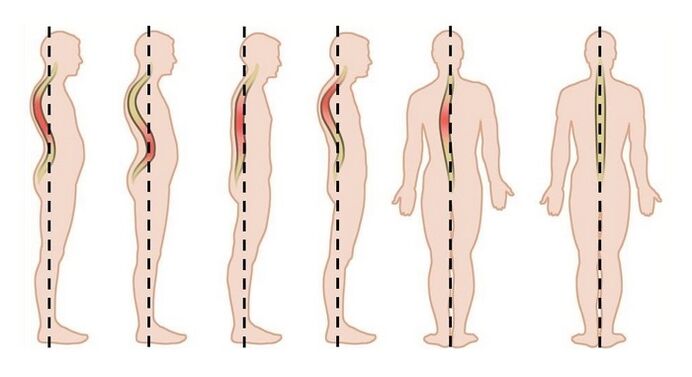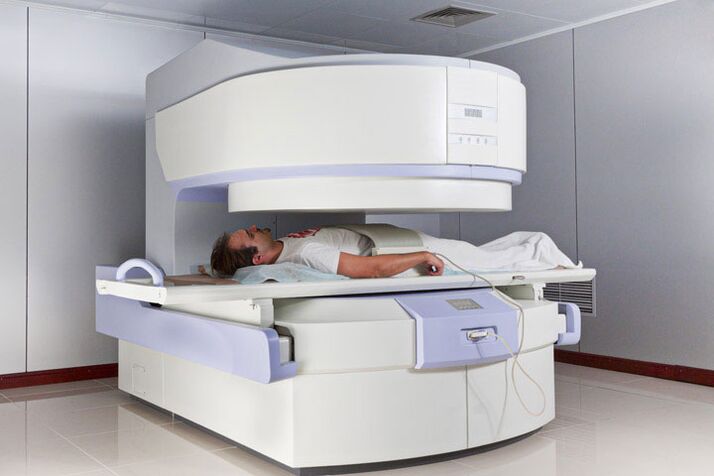
Osteochondrosis is one of the most commonly diagnosed pathologies of the spine. This pathology is of degenerative-dystrophic origin, affecting the intervertebral discs, leading to their structural and external modification. Doctors identify three types of the disease: osteochondrosis of the neck, chest, and lumbar, depending on the location of the abnormalities in the spine. If we talk about statistics of identified pathologies, it is believed that chest osteochondrosis is less common than other types. This is due to the peculiarities of the structure of the human spine in the thoracic region: the intervertebral plates of this part of the back are limited, which significantly reduces the likelihood of their traumatic injury.
What is chest osteochondrosis
The disease is difficult to identify because its symptoms are often similar to those of other organs: heart, stomach, and so on. It is dangerous in the consequences of chest osteochondrosis, so early detection provides more chances for timely correction and prevention of undesirable consequences. The disease is equally often diagnosed in patients of different ages, both sexes, including children. Let’s take a closer look at the causes and symptoms of chest osteochondrosis, medications and home treatment methods.
Osteochondrosis of the thoracic spine manifests as a degenerative-dystrophic disorder in the structure of the bone, the cartilage tissue of the vertebrae, which causes destructive processes to develop in them. In addition to the vertebrae themselves, the intervertebral discs also suffer: they stratify, their size decreases, causing the nerve endings in the intercostal space to be pinched. Together, this affects the normal functioning of the spine. Treatment started at the wrong time exacerbates the situation, which is subsequently resolved solely by surgery, which for various reasons cannot always be resolved by the patient.
Osteochondrosis of the chest can lead to the development of quite serious and dangerous diseases and conditions. It often causes pneumosclerosis, narrowed blood vessels, urogenital disorders, cancers, and so on. When osteochondrosis develops rapidly, it usually limits a person’s physical abilities: it is difficult to walk, work, and perform freely. normal activities.
In patients with osteochondrosis, the bone component of the vertebrae is damaged, then the cartilage, and finally the connective tissue and adjacent muscles are damaged.
If signs of osteochondrosis appear in childhood or adolescence, adolescence, it is a dangerous situation because it indicates that a person’s musculoskeletal system has begun to age without being fully formed and developed. Osteochondrosis of a child’s thoracic spine is rarely diagnosed. But the disease detected often refers to another dangerous disease.
Pathology occurs with approximately the same frequency in both men and women. There are no age priorities either. But it is worth noting that women are more prone to the disease during hormonal changes in the body - menopause.
If you start treatment for osteochondrosis of the thoracic spine at an early stage, there is a much better chance that the therapy will give a positive result.
Extent and characteristic symptoms of the disease
The development of osteochondrosis of the thoracic spine is gradual, with several stages differing. To properly organize the treatment process, one must understand the mechanisms of its development and progression.
- The initial stage of degenerative-dystrophic processes in the spinal column is characterized by a slight decrease in the size of the intervertebral plates. Minor cracks begin to appear on the surfaces of the annulus fibrosus of the intervertebral discs. The disc may protrude slightly from the spine. However, first-degree chest osteochondrosis does not present as a painful sensation, often a person is unaware of an onset of a dangerous disease. Computed tomography is used to detect the protrusion (slight loss) of the cartilage discs.
- If a person has grade 2 chest osteochondrosis, painful manifestations begin to appear on the back in the chest area. This can be explained by the fact that the nerve fibers are trapped. Muscle ligament apparatus of the back, i. e. muscle lacing, provides optimal support for the spine in the proper anatomical shape. In order to prevent spinal instability, it is extremely important to design the muscle structures of the back symmetrically. Otherwise, it is not only a violation of posture, curvature of the spine, but also excessive mobility of the individual elements. Due to the increased motility of the vertebrae, the nerve fibers leaving the spine through the intervertebral space are pinched. How does osteochondrosis manifest itself in the second stage? Back pain necessarily occurs in the second stage of chest osteochondrosis. It has different properties: it can be long-term or short-term traction, in the form of seizures. The situation is exacerbated by the fact that the nerve endings are compressed directly into the muscles, which are regularly in increased tone.
- The morphological signs of third-degree thoracic osteochondrosis are very pronounced, affecting all structural anatomical components of the spine. The patient has the following pathological picture: injuries and protrusions of the discs, the muscles and ligaments become inflamed, tears appear on them, the vertebrae move, and signs of arthrosis of the vertebral joints develop. The clinical picture of spinal disease in the third stage is very diverse. In addition to a person actually having pain in chest osteochondrosis, the patient loses tactile response to the part of the body where the injured nerve passes; have autonomic nervous system disorders associated with respiratory and circulatory disorders. It is difficult to breathe, heart pain, arrhythmia, shortness of breath occur. In addition, the patient develops multiple arthrosis of the joints at the same time, and pathological disorders begin in the functioning of the organs in the chest area. Similar symptoms occur when the intervertebral rupture decreases by two-thirds the height. Its size is determined by a chest x-ray, which is done in two projections: straight and lateral.
- With the development of degenerative processes in the spine, until the fourth degree of osteochondrosis, the intervertebral fissure narrows to a minimum, dangerous conditions such as spondylosis, spondyloarthrosis (characterized by abnormal changes in the intervertebral joints), spondylolisthesis. The body mobilizes its compensatory abilities to reduce the static and dynamic load on the spine, preventing injuries to the anatomical elements that cause the vertebrae to grow, flatten, and converge. The injured area of the annulus fibrosus is replaced by a bone structure, osteophytes (bone outgrowths) are formed, the spinal cord narrows due to the prolapse of the disc, the nerve endings are severely compressed, the motor activity of the chest is significantly limited, the person has constant pain in the chest.
- Due to the progression of the disease, the patient has lumbago in the lower back (lumbago), the legs are completely or partially paralyzed, the person loses his ability to work, becomes disabled.
The different symptomatic manifestations of the disease depend on different causes, including the genetic predisposition of the individual. The same symptoms of osteochondrosis of the thoracic spine occur differently in different patients. There is an objective explanation for this: various causes, conditions of occurrence, and the general state of human health lead to osteochondrosis. Symptoms of chest osteochondrosis in men appear slightly earlier than in women. The main reason for this phenomenon lies in the physiological structure of the female body: the hormone estrogen protects the intervertebral discs, so the change in hormonal background (pregnancy, menopause) creates particularly favorable conditions for the disease.
Many are interested in whether they will be taken to the army by osteochondrosis. If a conscript has first-degree osteochondrosis, he is enlisted in the Army. In the event that a young man has pronounced symptoms of the disease, this is noticed by a neuropathologist, they are likely to be delayed, in a neglected state (if they have polysegmental osteochondrosis of the thoracic spine), they may not call at all.
Reasons for appearance
At the onset of chest osteochondrosis, it manifests as virtually nothing. However, you need to know why it may appear. The following reasons provoke the pathology:
- Regular static or dynamic sprain strain due to active, strength training in professional athletes or athletes without the necessary load control.
- Traumatic bone damage, the joint elements of the spine, often lead to the fact that they do not fuse properly, they collapse quickly. Any damage to the spinal column is exacerbated by abnormal changes in the functioning of the structures of the nervous system and circulatory system. The necessary supply of nutrients to the bones is often restored over a very long period of time.
- Poor posture, congenital or acquired curvature of the spine, leading to imbalance of intervertebral discs.
- Sharp weight lifting when the majority of the load falls on the back chest. If a person performs such movements continuously, there is a high probability of developing chest osteochondrosis.
- Disorders of the endocrine system. In the event that the metabolic processes in the body are disrupted, all other organs and tissues do not receive the necessary nutrients and their regeneration is not adequate.
- Genetic preconditions of possible pathological processes of the vertebrae and intervertebral discs. In this case, chest osteochondrosis manifests itself in all ages.
- Insufficient physical and physical activity of a person, sedentary work. The muscular skeleton of the back weakens in this position, the nutrition of the tissues deteriorates, the elasticity of the spine decreases, and the risk of developing osteochondrosis of the chest increases significantly.
- Underdevelopment of all tissues of the musculoskeletal system, causing degenerative disorders in the spine. The cause is an unbalanced, excessive load on the spine.
- Various pathological changes in intervertebral discs. They may thin or, on the contrary, grow, and osteophytes may appear on them, disrupting the joints and damaging the blood vessels and putting pressure on the nerve fibers. The development of intervertebral hernias often provokes the progression of osteochondrosis.
- Inflammatory processes in the spine or nearby muscles often cause signs of chest osteochondrosis in women and men.
- Violation of the blood supply to the spinal cord due to narrowing or compression of veins and arteries.
- The consequences of infectious diseases are the development or exacerbation of osteochondrosis.
- Hypothermia, abuse of bad habits, nutritional imbalance.
- A special distinction is made between psychosomatics, i. e. constant stress, nervous excitement can also cause osteochondrosis.

There are several reasons for the development of chest osteochondrosis, so attention should be paid to prevention in order to prevent its development.
Common symptoms
Symptoms of breast osteochondrosis are similar in women and men. Usually, during exacerbation, progressive disease manifests itself with the following symptoms.
- Severe pain in the chest spine. They come from being in a long, uncomfortable position during physical work.
- Radicular syndrome due to compression of nerve endings.
- Intercostal neuralgia.
- Appearance of cramps in the back muscles.
- An altered condition of the heart muscle in which pain is not alleviated by taking special medications.
In addition, during a seizure of chest osteochondrosis, the patient may experience atypical symptoms: tachycardia, dizziness, heartburn, increased or decreased blood pressure. Body temperature does not usually change.
Diagnostic techniques
If the physician suspects that the patient has osteochondrosis, he recommends that the following tests be performed to diagnose the pathology.
- X-ray examination to determine: the boundaries, size, existing bone outgrowths, vertebral deformities, etc. of the intervertebral discs.
- Contrast-enhanced radiography allows the rate of plate death in the diagnosis of osteochondrosis of the thoracic region.
- CT or MRI shows the layered visualization of the altered structures. These techniques are used in the most difficult situations.
- Electromyography can be used to distinguish neurological signs associated with disease in the chest region.

The main rules of treatment
The following key points are observed in the treatment of osteochondrosis of the thoracic region:
- With the initial manifestations of signs of osteochondrosis, you can prevent its further development by improving your posture.
- Any, even minor, symptoms of the disease require conservative therapy.
- Long-term and systemic application of additional techniques in drug therapy is required to achieve a positive treatment outcome.
- If the disease is neglected, surgery is needed.
When deciding how to treat osteochondrosis of the chest region, the doctor will consider the stage of development of the disease, the individual characteristics of the patient, and possible side effects on the body.
Drug treatment
Conservative therapy involves the use of the following classes of drugs.
- Non-steroidal anti-inflammatory drugs, analgesics or glucocorticosteroids are prescribed to reduce the onset of pain and inflammation. They are available in different pharmacological forms (tablets, solutions for injection, ointments), so your doctor will advise you exactly what to treat the disease.
- Chondroprotectors are used to stimulate cartilage tissue repair.
- Anticonvulsants and muscle relaxants are used to relieve muscle cramps.
- To relieve unbearable back pain, the patient may be offered injections against osteochondrosis - blockade with anesthetics.
As a combined treatment for chest osteochondrosis, the following complementary treatment options are widely used.
- With acupuncture, you can get results quickly - relieving pain. The advantages of the technique include: high efficiency in a short time, rare occurrence of side effects in the body, insignificant list of contraindications, painless technique. Acupuncture is not practiced if a person is diagnosed with the presence of malignancies, mental disorders, exacerbation of inflammation, and pregnancy. The duration of treatment is chosen individually.
- The possibilities of manual therapy improve the blood supply to the injured areas of the body, reduce the intensity of pain, eliminate muscle cramps, restore ligaments, and slow down the development of osteochondrosis.
- The treatment of osteochondrosis with the help of physiotherapy is practiced everywhere as they are used to inject drugs into the sore spot. For example, electrophoresis with NSAIDs, glucocorticosteroids, etc. is used. . In addition to electrophoresis, UHF, magnetic therapy, and vacuum are often prescribed. The main goal achieved with physiotherapy techniques is to improve blood circulation in the painful area.
- Massage is often prescribed to relieve cramps in the back muscles. Classical massage is used during remission and vibration massage is used during acute periods. If the patient has an intervertebral injury, it is not recommended to use massage techniques.
- Physiotherapy is of great importance in treatment. The specific set of exercises is selected individually by the doctor in each case.
- Diet is important in the treatment of osteochondrosis. The patient's diet must include the necessary amount of protein, chondroitin (for this you must eat jelly, jelly meat, aspic foods), vegetables, fruits. You can’t eat too much; excludes the use of fried and fatty foods.
How to treat chest osteochondrosis at home
Treatment with folk remedies can also be practiced, but consult your doctor before using any of them. The following recipes are popular.
- To prepare the celery root infusion, take 3-4 g of raw material, grind, pour 1 liter of boiling water. After 8 hours, filter the infusion and drink it up to three times a day with a dessert spoon.
- To prepare the broth, take 2-3 sunflower roots, cut into 1 cm pieces, pour three liters of boiling water and boil for another 3 minutes. The cure is used like tea.
- You can make an ointment at home to rub against sore spots. Mix 150g of lard with 2 tbsp. l. wax, heat for 20 minutes in a water bath, then add 1 tbsp. l. pine oil, continue to heat the same amount, then add 1 tbsp. l. ammonia. Store the product in a glass jar in a cool place.
Home treatment of osteochondrosis of the chest is usually used as an adjunct to medication during a mild period or during exacerbation.
Osteochondrosis of the thoracic spine is a disease that must be taken seriously to avoid negative consequences. For successful treatment, you should carefully consider your doctor’s advice and follow them in a disciplined manner.



























